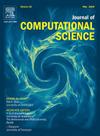Deep learning aided surrogate modeling of the epidemiological models
IF 3.1
3区 计算机科学
Q2 COMPUTER SCIENCE, INTERDISCIPLINARY APPLICATIONS
引用次数: 0
Abstract
The study of disease spread often relies on compartmental models based on nonlinear differential equations, which typically require computationally intensive numerical algorithms, especially for parameter estimation. This paper introduces a deep neural network-based surrogate modeling (DNN-SM) approach, engineered to accurately replicate the behavior of epidemiological models while significantly reducing computational demands. This approach adeptly handles the complexities inherent in nonlinear models and optimizes parameter estimation efficiency. We demonstrate the efficacy of the DNN-SM through its application to various disease models, including the Susceptible–Infected–Recovered (SIR), Susceptible–Exposed–Infected–Recovered (SEIR), and the more complex Susceptible–Exposed–Presymptomatic–Asymptomatic–Symptomatic–Reported (SEPADR) models. The results reveal that our DNN-SM not only forecasts solution trajectories with high accuracy but also operates approximately ten times faster than traditional ODE solvers for forward problems. By comparing the parameter estimation results of the DNN-SM and ODE solvers, we show that the DNN-SM produces highly accurate results with much less computational costs. The DNN-SM has been validated using both short-term and long-term COVID-19 data from several European countries. The results demonstrate that the DNN-SM provides accurate trajectories with significantly lower computational cost compared to traditional numerical methods.
深度学习辅助流行病学模型的代理建模
疾病传播的研究往往依赖于基于非线性微分方程的隔间模型,这通常需要计算密集型的数值算法,特别是参数估计。本文介绍了一种基于深度神经网络的代理建模(DNN-SM)方法,旨在准确地复制流行病学模型的行为,同时显着减少计算需求。该方法有效地处理了非线性模型固有的复杂性,优化了参数估计效率。我们通过将DNN-SM应用于各种疾病模型,包括易感-感染-恢复(SIR),易感-暴露-感染-恢复(SEIR)以及更复杂的易感-暴露-症状前-无症状-症状报告(SEPADR)模型,证明了DNN-SM的有效性。结果表明,我们的DNN-SM不仅可以高精度地预测解轨迹,而且在正向问题上的运行速度比传统的ODE求解器快约10倍。通过比较DNN-SM和ODE求解器的参数估计结果,我们发现DNN-SM以更少的计算成本产生了高精度的结果。DNN-SM已使用来自几个欧洲国家的COVID-19短期和长期数据进行了验证。结果表明,与传统数值方法相比,DNN-SM提供了精确的轨迹,且计算成本显著降低。
本文章由计算机程序翻译,如有差异,请以英文原文为准。
求助全文
约1分钟内获得全文
求助全文
来源期刊

Journal of Computational Science
COMPUTER SCIENCE, INTERDISCIPLINARY APPLICATIONS-COMPUTER SCIENCE, THEORY & METHODS
CiteScore
5.50
自引率
3.00%
发文量
227
审稿时长
41 days
期刊介绍:
Computational Science is a rapidly growing multi- and interdisciplinary field that uses advanced computing and data analysis to understand and solve complex problems. It has reached a level of predictive capability that now firmly complements the traditional pillars of experimentation and theory.
The recent advances in experimental techniques such as detectors, on-line sensor networks and high-resolution imaging techniques, have opened up new windows into physical and biological processes at many levels of detail. The resulting data explosion allows for detailed data driven modeling and simulation.
This new discipline in science combines computational thinking, modern computational methods, devices and collateral technologies to address problems far beyond the scope of traditional numerical methods.
Computational science typically unifies three distinct elements:
• Modeling, Algorithms and Simulations (e.g. numerical and non-numerical, discrete and continuous);
• Software developed to solve science (e.g., biological, physical, and social), engineering, medicine, and humanities problems;
• Computer and information science that develops and optimizes the advanced system hardware, software, networking, and data management components (e.g. problem solving environments).
 求助内容:
求助内容: 应助结果提醒方式:
应助结果提醒方式:


